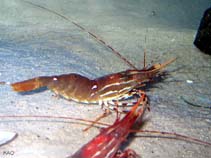Pandalus platyceros Brandt, 1851
Spot shrimp| Native range | All suitable habitat | Point map | Year 2050 |

|
| This map was computer-generated and has not yet been reviewed. |
| Pandalus platyceros AquaMaps Data sources: GBIF OBIS |
Classification / Names Common names | Synonyms | CoL | ITIS | WoRMS
Malacostraca | Decapoda | Pandalidae
Environment: milieu / climate zone / depth range / distribution range Ecology
Benthic; depth range 0 - 2648 m (Ref. 91801), usually 45 - 234 m (Ref. 91824). Temperate; 60°N - 27°N, 167°W - 113°W
Distribution Countries | FAO areas | Ecosystems | Occurrences | Introductions
Eastern Pacific: The west coast of north America from Unalaska Island to Kachemak Bay and Prince William Sound south to Punta Eugenia, Baja California Sur, Mexico.
Length at first maturity / Size / Weight / Age
Maturity: Lm ? range ? - ? cm Max length : 30.0 cm TL male/unsexed; (Ref. 91741); max. published weight: 120.00 g (Ref. 91741); max. reported age: 6 years (Ref. 104007)
Short description Morphology
"Prawn" of British Columbia, sometimes called the giant shrimp. The body is stout; the carapace covered with a dense short pubescence. The colour of the adults is fawn to red with several distinct white stripes and spots, but the younger individuals show a variety of coloration. Some are green, others brown, while yet others show the red of red algae and
hydroids. This colour change seems to correspond to a change in habitat, for the young specimens live in comparatively shallow water amongst seaweeds and hydroids, while the older individuals go down into deep water. The rostrum is one and a half to one and two thirds times as long as the carapace. There are 14 to 17 dorsal spines extending to the middle of the rostrum, and usually a solitary spine not far behind the acute tip, while the lower limb is armed with 7 or 8 fixed spines.
Maximum depth from Ref. 104449. Maximum common depth from Ref. 104007.
Life cycle and mating behavior Maturity | Reproduction | Spawning | Eggs | Fecundity | Larvae
Protandrically hermaphroditic. Initially develops and functions as a male and transforms into females after about 3 to 5 years and remains as female onwards (Ref. 91741). Males become sexually mature when 15 cm TL is reached (Ref. 91750).
Main reference
References | Coordinator | Collaborators
Butler, T.H. 2011. (Ref. 91750)
IUCN Red List Status (Ref. 130435: Version 2024-1)
CITES status (Ref. 108899)
Not Evaluated
CMS (Ref. 116361)
Not Evaluated
Threat to humans
Human uses
Fisheries: commercial
| FishSource |
Tools
More information
Trophic Ecology
Ecology
Population dynamics
Life cycle
Distribution
Human Related
Aquaculture profile
Stamps, Coins Misc.
Stamps, Coins Misc.
Outreach
References
Internet sources
BHL | BOLD Systems | CISTI | DiscoverLife | FAO(Publication : search) | Fishipedia | GenBank (genome, nucleotide) | GloBI | Gomexsi | Google Books | Google Scholar | Google | PubMed | Tree of Life | Wikipedia (Go, Search) | Zoological Record
Estimates based on models
Preferred temperature
(Ref. 115969): 4.2 - 6.6, mean 5.3 (based on 121 cells).



